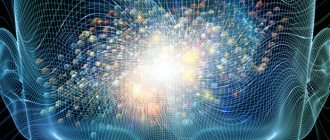The birth of a child is not only a great happiness, but also a great responsibility for parents. After all, it depends on mom and dad how developed their baby will grow physically, mentally and emotionally. The job of parents is not to just stand on the sidelines and watch their child grow. They need to try to help the baby grow into a well-rounded personality. In our article we will look at what the harmonious development of children is. We will definitely dwell on the methods and principles of education, talk about the need to create conditions for the comprehensive development of the child, and present tips and recommendations from psychologists.
What is the harmonious development of a child’s personality?
Raising children is a complex and responsible process. And the main goal, the so-called ideal, is the “creation” of a harmoniously developed personality. It’s just impossible to choose a single template that will suit a particular child, since each person, starting from the moment of his birth, is an individual.
The harmonious development of a child’s personality as a goal involves raising a comprehensively developed person: physically, psychologically, intellectually. All these sides are equally important and complement each other in every possible way. It is impossible to achieve harmony as a whole if you do not pay enough attention to each component:
- Physical development involves the development of the body. A healthy, strong and resilient person will easily perceive different energy flows.
- Psychological development affects the emotional sphere, the soul. Starting from childhood, a person learns to master art, appreciate beauty, etc.
- Intellectual development. During his life, a person must understand the world and himself. The task of mom and dad is to help the child realize his mental abilities to the maximum.
Parents must combine all three components together and create all the necessary conditions for the comprehensive development of their child.
How to cultivate a harmonious personality
There are certain principles, following which will allow you to find harmony over time.
- It is important to always remain yourself. Today you can meet people who do not want to demonstrate their true feelings even to themselves; they limit themselves to far-fetched norms and rules. As a result, it turns out that a person himself does not know what exactly he wants. Due to this, he does not achieve any success, because without knowing what you want, you cannot achieve what you want. Therefore, stop following imposed stereotypes, understand that you must be yourself, do not be shy about your desires and achieve what you really want.
- Don't be afraid of change. Of course, many people plan their lives ahead. However, no one is immune from possible changes and unforeseen situations. A harmoniously developed person differs from an ordinary person in that he allows himself to make mistakes, he does not blame himself for the fact that something did not go the way he would like, he is able to adapt to changes, and does not take possible failures to heart.
- Don't remember bad things. Some people carry some kind of negative information through the years, storing in their memory what still causes unpleasant emotions today. The correct thing is the desire to let go of the past, to understand that it cannot be changed, that it should not affect the future.
- See the beauty of the world around you. It is important to learn to recognize the beauty around you. Many of us are accustomed to monotonous everyday life, not noticing what is happening around us. Few people pay attention to the singing of birds, to the dew on the leaves of trees, to the first buds or opening flower buds. And sometimes it’s worth not rushing at breakneck speed to work or school, but stop for a second and look around, notice the beauty of nature. You also need to go into the forest more often, go to the park, in order to directly contact the outside world.
- Laughter prolongs life. It has been scientifically proven that people who have a positive attitude towards life are significantly less likely to experience stress. Positive emotions have a beneficial effect on overall health. A person's anxiety level decreases.
An individual who wants to find harmony needs to learn to adhere to the following practices:
- self-control - it is important to learn to resist your addictions and control them;
- the ability to analyze committed actions and draw conclusions based on them - this allows you to understand your true desire, make your actions responsible and conscious;
- the ability to analyze one's thoughts.
Now you know what it means to form a harmonious personality. As you can see, a person must strive for harmony with his inner, spiritual world and everything that surrounds him. Try to change your life for the better, strive for harmony.
When to start raising a child?
Infancy is the first step on the path to harmonious development. Children absorb all information like a sponge, so education and development of their intellectual abilities should be done from birth - at three or five years old it may be too late. Scientists studying human potential have concluded that 1.5-2 years is the optimal age to teach a child to read.
The generally accepted methods used today are not aimed at the harmonious development of the individual, but at raising a person convenient for society. They are based on literally driving knowledge into a child’s head, making him obedient to parents, polite to teachers, etc. At the same time, parents who want their baby to grow up harmoniously developed should not put much hope in kindergartens and schools . It is necessary not to assign the responsibility for education to government agencies, but to do it independently. But the main thing is that you need to do this with love for your child.
Harmonious development of personality
| The article is presented “as is”. |
For many centuries, the progressive minds of mankind dreamed of the harmonious development of personality, that is, the comprehensive development of physical qualities, mental abilities and high morality of a person. However, dreams of an ideal personality remained a utopia. In a society based on the exploitation of man by man, unemployment, poverty, and social inequality lead to the fact that children of the poor classes grow up physically weakened and do not have ample opportunities for full spiritual development.
K. Marx and F. Engels proved that only “a society organized on communist principles will enable its members to fully use their fully developed abilities.” With the emergence of Marxism, issues of education were elevated to the level of a science about the harmonious development of the physical and mental abilities of the individual during the period of socialism and communism.
l
With the victory of the October Revolution, for the first time in the history of mankind, opportunities opened up for the practical implementation of the idea of harmonious development of the individual. The ideal of harmonious, all-round development of the individual in a socialist society for the first time became a real goal of education. Opportunities have opened up for the practical implementation of the idea of harmonious, comprehensive development of the individual. Equality of citizens was realized regardless of gender, religion, nationality, everyone was given an equal right to work and education.
V. I. Lenin put forward the task of creating a new education system among the most important state tasks requiring the most serious attention.
Speaking about the content of comprehensive education, V.I. Lenin repeatedly pointed out that it must necessarily include physical education. In physical exercises, V.I. Lenin saw a source of health, a wonderful means of preparing for work, and a wonderful rest. “Young people especially need cheerfulness and vigor. Healthy sports - gymnastics, swimming, excursions, physical exercises of all kinds - versatility of spiritual interests, teaching, analysis, research, and all this, if possible, together! - wrote V.I. Lenin.
Determining the ways of forming a person in a communist society, our party sets as its goal the need to “educate a new person who harmoniously combines spiritual wealth, moral purity and physical perfection.” The combination of ideological conviction, high education, good manners, moral purity and physical perfection are the necessary qualities of a harmoniously developed personality. General Secretary of the CPSU Central Committee, Chairman of the Presidium of the Supreme Soviet of the USSR L. I. Brezhnev Fr.
Physical perfection is good health, perfect and comprehensive development of the whole organism, a high level of development of physical qualities, motor skills and abilities. Physical perfection should be considered not as a prospect for the distant future, but as an everyday practical task of every member of our society and all work in the field of physical culture. V.I. Lenin possessed all the necessary qualities of a harmoniously developed personality. The first People's Commissar of Health N.A. Semashko wrote: “Lenin was a physically strong, strong man. His stocky figure, strong shoulders, short but strong arms - everything revealed remarkable strength in him. Lenin knew how, to the best of his ability, to take care of his health. Because he could, that is, because his overly intense work allowed it. He didn't drink or smoke. Lenin was an athlete in the most precise sense of the word: he loved and appreciated fresh air, exercise, swam beautifully, skated, and rode a bicycle. While in St. Petersburg prison, Lenin did gymnastics every day, walking from end to end of the cell. In exile, every free day, the whole group of us went out of town on bicycles.” Our cosmonauts can also be called harmoniously developed personalities, combining high patriotism, professional skill, and physical perfection. In space flight, hardening and endurance are necessary as well as scientific and technical training, a broad outlook, and a readiness to come to the aid of a comrade at any moment.
Comprehensive personal development is a long process, and it would be naive to believe that in such and such a year all people will be harmoniously developed. Of course, such a time will come, and it is our duty to bring it closer.
Active participation in the public life of the school, good academic performance, initiative and independence, cultivating a sense of teamwork and strengthening one’s health—this is what is primarily required of young people.
General principles of harmonious development
When raising children, you should adhere to the following principles:
- There is no need to instill in your child the idea that adults are smarter than children just because they are older than them.
- Not to teach children, but to stimulate their interest in learning so that they can learn it themselves.
- Do not force children to do anything without their desire, try not to use coercive measures against them, except in cases where this cannot be avoided.
- Adults should take into account the child’s choice and agree with it only if it (the choice) is not capable of harming their health.
- The process of gaining knowledge is more important than the result.
For the all-round harmonious development of a child, it is important to devote enough time to the education of the soul. This concept includes the practice of art, communication with nature, knowledge of the laws of nature and the laws by which people live, the ability to love oneself and loved ones. In this regard, you should not rely too much on educational institutions. The best education and development for a child can be given by his loving parents.
Child growth standards and reasons for its decline
Before talking about pathology, it is necessary to determine the normal physiological growth increases.
For children under one year old and for older children, there are different criteria for growth norms - monthly increases and determination of the normal growth rate using centile tables.
Monthly growth increases in children of the first year of life
Features of growth increase in the first year of life for full-term children:
- On average, the baby gains 3 cm over a monthly period.
- The total increase in the first year of life should be at least 25 cm. Thus, the normal figure for a one-year-old baby is from 74 to 76 cm.
- Children grow more rapidly in the first months after birth, after which this process slows down.
Months of life:
1-3 months – 3-3.5 cm monthly;
4-6 months – 2.5 – 3 cm;
7-9 months – 1.5 cm;
10 – 12 months – 1 cm.
The child's height, as well as his weight (for children in the first three years of life + head circumference) should be measured annually.
Parents should monitor this, because in the event of any deviations from the norm and/or the appearance of various symptoms indicating the development of diseases, including endocrine ones, these indicators will be of great importance for the timely diagnosis of the disease, further observation and the effectiveness of the prescribed treatment.
As an endocrinologist in my practice, I often encounter retardation in height and weight, and the lack of annual height and weight indicators significantly complicates a preliminary diagnosis - from constitutional growth retardation to a decrease in physiological annual growth in somatic pathology and true endocrine pathology.
It is important to know not only how much the child is stunted in growth, but also when and for what reason these changes occurred - from birth or after a certain period of time.
Centile tables
After one year, height is correctly determined using centile tables that determine the child’s growth levels.
To determine the approximate correspondence of height and weight to age, different formulas are found on different sites; they are more for parents and are indicative in nature. You should be aware that they have significant errors, do not take into account the gender of the child and indicate average height and weight values.
Centile tables were compiled based on WHO studies that were conducted in the period 1997-2003. and in which the growth standards for children are read depend, first of all, on the gender of the child, therefore, for girls and boys, WHO has created separate tables with average indicators.
Depending on the age of the baby, the ratio of body length and weight, as well as growth, will also differ. In addition, using centile tables, you can determine growth levels and their annual changes, you can build a growth curve and determine its degree of deviation from the average values, and in case of short stature - dynamics of change before and after treatment.
Growth levels according to centile tables:
- less than 3% – very short stature (short stature) – the child must be examined by an endocrinologist;
- from 3% to 10% – short stature – requires observation, if additional symptoms are present, examination is necessary;
- from 10% to 25% – growth below average (variant of the norm, observation by a pediatrician);
- from 25% to 75% – average growth;
- from 90% to 97% – high growth – observation by a pediatrician, normal variant; more than 97% – very tall (tall) – observation and examination by an endocrinologist.
The same indicators from paracentile tables are used to estimate a child’s weight.
The harmony or disharmony of physical development in children is assessed by body mass index (BMI) - weight/height squared. Today there are many convenient calculators for calculating BMI.
- Development is harmonious - when the child is classified from the 10th to 90th centile corridor according to BMI;
- disharmonious – from the 3rd to the 10th and from the 90th to the 97th centile corridor according to BMI
It is also necessary to determine the proportionality index:
Weight-height coefficient (in full-term newborns at birth)
Weight/Height× 100% normal
= 60 – 65%;
I degree of intrauterine growth retardation
– 59-55%;
II degree
– 54- 50%;
III degree
– less than 50%.
It should be borne in mind that these tables are used only for full-term newborns.
Growth - norms and pathology in premature babies
In premature infants, it is necessary to determine the correspondence of physical development to the gestational age. Development corresponds to gestational age when assigning weight, body length, head circumference, weight-height coefficient from the 10th to the 90th percentile.
Intrauterine growth retardation is diagnosed with consistently low indicators with two or more measurements below the 3rd percentile - with height less than 48 cm, weight less than 2200 g.
All children with intrauterine growth retardation must be observed by a pediatric endocrinologist.
After 43 weeks, assessment of physical development is carried out according to charts for young children, but taking into account the corrected age (the difference between the actual postnatal age in weeks and the weeks of gestation missing to full term).
The highest growth rates of premature babies are in the first 3 months of life (3.5-5 cm per month).
- In the first half of the year, the monthly increase in height is 2.5-5.5 cm,
- in the second half of the year - 0.5-3 cm.
The total increase in height per year is 27-38 cm. The average height of a newborn child by year is 70.2-77.5 cm.
The body weight of premature babies in the 1st year increases 6-7 times; an increase of 20 g/kg body weight at birth is adequate. Anthropometric indicators are equal to those of full-term children aged approximately 2 years, but with a body weight of up to 1500 g. indicators are lagging behind.
In any case, if there is a change in growth rates, parents need to pay attention to this, and if there is a persistent deviation, consult a pediatric endocrinologist.
Main causes of stunting
Most often, stunting is caused by the constitutional characteristics of the child’s growth and development.
Highlight:
- Constitutional delay in growth and puberty (late puberty syndrome).
- Familial short stature.
- Congenital somatotropic deficiency - isolated or with multiple hormone deficiency).
- Acquired somatotropic insufficiency.
- Laron syndrome occurs when the sensitivity of receptors to growth hormone is impaired.
- Hypothyroidism (thyroid hormone deficiency).
- Short stature due to genetic diseases (Shereshevsky-Turner, Nonne syndrome).
- Pseudohypoparathyroidism (Albright's syndrome).
- Somatically caused growth disorders - congenital and acquired chronic diseases (heart, kidney, liver, blood, intestines, metabolic disorders, pathology of the skeletal system).
Other causes of stunting
Many factors can have a negative impact on the processes of growth and development. The main ones are genetic and environmental changes that can affect the fetus even in the prenatal period.
Environmental factors
Damaging exogenous (external) factors during the period of intrauterine development can be chemicals, including many drugs, ionizing radiation (for example, X-ray in diagnostic doses), hypoxia, fasting, drugs, nicotine, viruses, etc.
Chemicals and drugs that penetrate the placental barrier are especially dangerous for the fetus in the first 3 months of pregnancy, as they accumulate in elevated concentrations in the tissues and organs of the fetus.
Drugs impair brain development. Starvation and viruses cause malformations and even intrauterine death.
Chronic diseases, as well as medications, can affect the growth processes and maturation of the fetus and, subsequently, the child.
Therefore, it is extremely important to protect the future baby from their harmful effects:
- eat rationally, while eliminating all foods that can have a negative effect (allergens, fats, preservatives, food additives, a lot of sugar);
- minimize the use of medications;
- monitor your health so that you can respond in a timely manner to the development or exacerbation of diseases;
- reduce active motor and emotional stress.
Genetic factors
It is very difficult to recognize the role of genetic factors and yet they can be foreseen - the genetic basis of growth hormone deficiency in the presence of first-degree relatives with the same pathology in 5-30% of cases.
This is due to various mutations in the PIT-1, PROP1 (prophet of Pit1), GH1 genes, which regulate the development of the pituitary gland during embryonic development. Today, they have a recessive inheritance pattern (i.e.
An important factor must not be present in both parents - consanguineous marriages or people living for a long time in the same territory - short stature is considered an ethnic feature of some peoples.
In this situation, if close relatives have growth hormone deficiency, isolated or in combination with other manifestations of disorders of the hypothalamic-pituitary region, children suffering from growth disorders, it is possible to conduct a molecular genetic examination of the parents and determine the risks of developing growth hormone secretion in the child and related health problems in the future.
Manifestations of growth retardation and the formation of congenital forms of short stature are noticeable already in the first 3-6 months of life, if this is combined with a burdened family history (the presence of first-degree relatives with the same pathology with short stature) or a closely related marriage - the baby must be examined by a pediatric endocrinologist.
Stunted growth of a child in the first years of life may be associated with exposure of the fetus to negative external or internal agents:
- difficult pregnancy;
- taking medications;
- taking alcohol or drugs, smoking;
- frequent stress during pregnancy.
These children should also be observed by a pediatric endocrinologist.
External factors after birth
The most common cause of somatotropic insufficiency is tumors of the central nervous system of various etiologies, primarily affecting the hypothalamic-pituitary region. After treatment of such tumors (surgery, radiation therapy, chemotherapy), as a rule, manifestations of hypopituitarism (somatotropic insufficiency) increase.
Injuries are also possible, including birth injuries with asphyxia and fetal distress - difficult childbirth, aids used (obstetric Spitz, vacuum fetal extraction), rapid birth.
Significant reductions in growth rates are observed after treatment of tumors that do not affect the hypothalamic-pituitary region - irradiation of the head and neck for leukemia, medulloblastoma, retinoblastoma, lymphogranulomatosis. A decrease in growth hormone production is observed after chemotherapy.
A number of space-occupying formations that are anatomically unrelated to the pituitary gland may be accompanied by a decrease in the production of growth hormone - optic nerve glioma, astrocytoma, localized in close proximity to the hypothalamic-pituitary region.
pediatrician, pediatric endocrinologist Olga Ivanovna Sazonova
Source: https://zen.yandex.ru/media/mirmam/normy-rosta-rebenka-i-prichiny-ego-snijeniia-5dbd2883e3062c00b16a00a3
Education methods
In the process of harmonious development of children, the following methods of education are used:
- Suggestion. The method involves influencing the child’s emotions, feelings, and through them his will and mind. As a result of suggestion or self-hypnosis, a person begins to worry about his actions and analyze them.
- Belief. This method is based on logical conclusions made by the child. Belief contributes to the formation of views or concepts. To implement the method, fables, excerpts from literary works, and historical analogies are used.
- Exercise. The purpose of this method is the formation of skills and habits as a result of repeated repetition of similar actions, bringing them to automatism.
- Encouragement. The method is a positive assessment of the child’s actions. This is approval, praise, gratitude, reward. Encouragement builds self-confidence and self-confidence.
When choosing one or another method of education, it is important to take into account the age of the child, his age and personality characteristics.
How to develop harmoniously?
Reading Time: 4 min.
The seventh habit of highly effective people is continuous development. Stephen Covey
Without development there is no efficiency. Efficiency is a consequence of constant, continuous development. The same thing happens in nature. First, the mechanisms inherent in a person act. God made it so that until the age of 25, our development occurs automatically. The body develops and hormones are produced. There is a power that comes from within. But after this, natural development stops. And in order to develop, you need to create stressful situations for yourself. Step out of your comfort zone. Learn new ways to achieve goals. And – constantly develop.
Development is proceeding in four main directions:
Physical development
You need to develop your body. Gym, exercise, new types of movement...Physical activity and activity. The reverse process of this is immobilization. If physical development stops, complete degradation occurs. The muscles atrophy and the body collapses. Body development comes through leaving your comfort zone. Through small stressful loads. The body adapts to them and develops.
Emotional development
Scientists say that emotional intelligence is more important than IQ. Than the level of intelligence. What is emotional intelligence? A person lives in a certain emotional background. This background changes several times a day. And the quality of life depends on the quality of emotions. Those that a person experiences constantly. A person who experiences positive emotions lives a happy life.
Development in the emotional sphere dramatically increases the quality of life. You need to learn to love. Learn to see beautiful, joyful things. See them in yourself and in people. Learn to deal with situations calmly. Even when things don't go according to your plan.
Learn to explore your emotions. Especially the negative ones. Then you will understand what is going wrong in your life. This will allow you to develop. It improves life. You become positive and life becomes joyful, happy and full. Emotional development is the path to happiness.
Intellectual development
Everyone lives in their own model of the world. The one he knows about. Previously, for example, there was one model. That the Earth is flat stands on three pillars. Just imagine, it sits on such a tray. And the tray has 3 pillars. And the Sun revolves around the earth. Then people learned that the Earth is round. Some believed it, some didn't. Then everyone believed it. And now we live in another world, which is round and flies around the Sun.
The more a person learns, the more his world expands. He goes out into new worlds. Intellectual development allows a person to understand how to build a model of the world in which he will be the most effective, happy and productive.
What is included in intellectual development? Acquiring the necessary knowledge and skills to achieve goals. For example, to achieve happiness. What is happiness? The answer lies in the plane of intellectual development. Now, reading this article, you are developing intellectually.
Develop your intellect! Load the best programs into it! And you will achieve maximum efficiency!
Spiritual development
It goes into infinity. It begins when a person changes his picture of the world. Introduces into it the concepts of “G-O-G”, “creator”, “creator”, “soul”, “spiritual world”... When he thinks on this topic. When it begins to act to enhance the spiritual component. Then spiritual development becomes a significant part of life, and a person moves towards eternity.
Everything material is subject to destruction. The material world is limited by time and space. And the spiritual world is limitless. There are no barriers in it. Prayer, the movement of the soul towards B-O-G-U is the path to eternity. Develop spiritually - and you will move towards eternity!
How to combine different areas of development?
Stephen Covey advised paying attention to all 4 areas. Everyone - every day. Covey studied the Bible for half an hour every day. For spiritual development, for example, I study Torah every day. Holy books. I devote about an hour a day to this. The second component is prayer: gratitude and requests to B-O-G-U. Also - about an hour during the day.
For intellectual development. Constant, daily reading of educational and inspiring literature. Do you want to live an effective life? Create a new habit. Read articles and educational books at least half an hour a day. They will give you new patterns and patterns of thinking.
Emotional development is linked to spiritual development. This is work to improve character qualities. It happens constantly throughout the day. It is built into all other activities. And the main element of emotional development is the ability to rejoice. The desire to rejoice. Find something you can be happy about! And correct your negative attitudes that lead to negative emotions.
Physical development. Pierre Dukan, the world's leading nutritionist, says: “A person who does not actively move for at least 20 minutes a day is not called a person.” I often repeat this phrase. The body is made to move. 20 minutes a day is the minimum. Exercise, exercise... And 3 times a week - serious sport. Developing, teaching the body new movements and skills.
Exercise
Do exercises for your body every hour. 5 minutes of flexibility or strength exercises every hour will make the next 55 minutes ALIVE. Every hour, close your eyes, at least for 1 minute, and tell yourself: COMPLETE RELAXATION. With each exhalation, the muscles relax. Read Tony Buzan's book Super Thinking. Find a religious site for your denomination and read at least one article a day. Finally, ask G-d to help you in your affairs.
You can learn even more about development and thinking, coaching and tools to achieve any goals in the 7-week online training “The New Coaching Code”. Register now!
Physical development of children
Harmony represents the development of all aspects of human activity. Both body and soul must develop equally. If parents want their baby to be healthy, smart and cheerful, in the process of raising him, they must pay attention to his harmonious physical development.
A child who receives feasible physical activity increases his functional capabilities. He learns to rationally use his internal energy reserves and achieve much more than his peers. Simultaneously with physical activity, the development of intelligence occurs. It is not at all necessary (although this will only be beneficial) to send your child to sports clubs. It is enough to replace them with daily exercises and active walks (with a bicycle, scooter, roller skates, etc.).
Description of a harmonious personality
Every person has the desire to achieve internal balance, balance in the physical, social and spiritual areas of life. The harmonious coexistence of all these aspects is the direct path to happiness.
The ability to ensure harmony between soul and mind, to live without internal and external conflicts, determines the quality of a person, which we call harmony.
A harmoniously developed personality is characterized by ingenuousness, directness and calmness. Behavior directly corresponds to experienced feelings, sincere and sincere. A harmonious person does not wear a mask and always says what he thinks. She will never enter into open confrontation; instead, she will try to understand the reasons for what is happening.
A harmonious personality is characterized by insight. She prefers to look for the sources of human actions not on the surface, but in the depths of her soul. Therefore, it evokes a feeling of confidence, security and peace in people; they want to open up and trust.
A harmoniously developed personality relies on its knowledge, conclusions, life experience and feelings. It is distinguished by the belief that using one’s internal resources, a person is able to achieve positive changes, first of all, in himself. And he considers this more important than external changes. She is confident in this because she herself made it possible, gained inner value, freedom, self-love.
A harmoniously developed person always has a choice: how to react, what to do, what to participate in. Priorities are focused on health and opportunities, judgment and conflict are excluded. A harmonious person will never be drawn into any situation against his will.
She is always emotionally balanced, calm and in good health. She is interested in a healthy lifestyle and her development in various directions. She does not pursue recognition and power, she shows herself only where she is interested and achieves goals that are important exclusively to her. A harmonious personality does not live in dreams and fantasies, but stands firmly on its feet in reality.
It is not in her nature to wait and hope, so she cannot be unsettled by unexpected results or unpredictable consequences. This is because a harmonious person does not seek the meaning of life, but simply lives and does what he considers necessary. Despite her sociability, she will never continue communication that is not interesting to her and will never stay in the company if she feels uncomfortable. Loneliness does not cause suffering for a harmonious personality; rather, on the contrary, she knows how to enjoy it.
What is needed for the comprehensive development of a 1 year old child?
A baby who is not yet 12 months old already has enormous potential for development. Therefore, the task of parents is to use it to the fullest. And for this they should follow some rules:
- Create a developing atmosphere for the child. We are talking not only about expensive and functional toys, but also about joint walks with the study of everything that surrounds the baby: trees, insects, etc.
- Carry a child in your arms. In close proximity to the mother, the baby feels safe, which means he grows up more psychologically stable and calm.
- Talk a lot with your child. For the harmonious development of children in the family, it is important to form in the child a positive attitude towards the world from birth. At first this happens through affectionate addresses to the baby, and a little later through funny songs, nursery rhymes and jokes.
- Do not compare your child with other children. Each baby has its own innate abilities, so you should not try to surpass someone in development and demand unbearable results.
Conditions for the harmonious development of a preschool child
These conditions include:
- Having an adult nearby. We are talking about a loved one, mother, father or grandmother, to whom the child can sit on his lap at any moment, hug him, and share secrets. And those parents who believe that a four-year-old child needs mother’s love and affection less than a baby do are very mistaken.
- The same principles of education in the family. The child will only be able to understand them when all the rules are the same: if they punish, then both mom and dad, etc.
- Child development in play. Over time, the baby should become familiar not only with simple toys, but also with story-based games and role-playing games. And his mom and dad will help him with this.
- Moderate loads. For the harmonious development of preschool children, daily walks, music lessons with learning songs, and exercise are important. But you shouldn’t overload your baby with classes and homework. Everything has its time.
- An example to follow. It is unlikely that a child will eat healthy cauliflower if the parents eat fried potatoes. For a child to grow up healthy and successful, he needs a role model.
- Personal space. A child needs, if not a separate room, then at least his own corner.
Features of the harmonious development of a teenager
From the age of nine, a child experiences both physical and emotional changes. All feelings and emotions manifest themselves very violently. Teenagers become too irritable and get offended over trifles. You should know that such changes are quite natural for this age.
During adolescence, difficulties may arise in communicating with peers and with parents. During this period, it is important not to put strong pressure on the child (especially by introducing a system of prohibitions), and try to find a common language with him. For the harmonious development of a teenager it is necessary:
- teach him to manage his emotions;
- avoid categoricalness and maximalism;
- think positively;
- provide a balanced diet, sufficient time for sleep and rest;
- control studies;
- monitor compliance with the daily routine.
Despite your workload, try to find time to communicate with your child, walk in the fresh air, relax in nature, exercise and play sports.
Aspects of the comprehensive development of the child
- Physical development: maintaining the child’s physical fitness and comprehensive care for his health.
- Intellectual development: increasing mental abilities, developing logical and creative thinking, the ability to be aware of one’s own actions and their possible consequences.
- Social development: communication skills, the ability to communicate, express thoughts, share ideas, interact with a team.
- Emotional development: the ability to manage oneself and one’s experiences, restrain or transform negative emotions, express one’s feelings, understand and accept the feelings of other people.
- Creative development: revealing abilities and realizing the child’s creative potential.
- Spiritual development: understanding and adherence to moral principles, acceptance of universal human values and ideals.
The comprehensive development of a child makes him a realized person in all respects and lays the foundation for a future successful life.
Recommendations for education and harmonious development of personality
The following advice from psychologists will be very useful for parents of children of any age:
- Accept the child for who he is.
- Do not consider the child to be his property.
- Love your child, be honest with him and be patient with your baby.
- Don't take parenting too seriously.
- Respect your child.
- Give the child freedom in his development and in choosing what he wants to do.
Using the best modern techniques will be completely useless for the harmonious development of children in the absence of love and understanding on the part of their parents.











